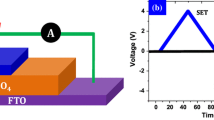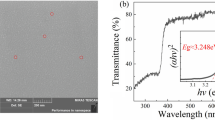Abstract
HfO x based resistive switching devices with thin AlO x layer inserted between HfO x and TiN top electrode (TE) and Pt bottom electrode (BE) were fabricated respectively. Both devices show robust bipolar resistive switching phenomenon. Experimental result reveals that TiN/AlO x /HfO x /Pt device with appropriately thick HfO x film shows significant enhancement in performance as compared with other samples, having lower voltage and excellent uniformity. The role of inserted AlO x layer and thickness of HfO x film on resistive switching properties are discussed and clarified through comparative experiments, which is considered to be a doping effect. The experimental result is consistent with the model where resistive switching happens near TiN top electrode (TE) due to partial rupture and reconstruction of conducting filaments (CFs) assisted by the doping. The different doping profiles near top electrode of the samples were confirmed by XPS depth analysis. This work provides detailed information about the optimization of HfO x based resistive switching device by a doping profile modification approach.
Similar content being viewed by others
References
Baek I G, Lee M S, Seo S, et al. Highly scalable nonvolatile resistive memory using simple binary oxide driven by asymmetric unipolar voltage pulses. In: Proceedings of IEEE International Electron Devices Meeting, San Francisco, 2004. 587–590
Meijer G I. Materials science—who wins the nonvolatile memory race? Science, 2008, 319: 1625–1626
Waser R, Aono M. Nanoionics-based resistive switching memories. Nat Mater, 2007, 6: 833–840
Chen F T, Lee H, Chen Y S, et al. Resistance switching for RRAM applications. Sci China Inf Sci, 2011, 54: 1073–1086
Lee H Y, Chen Y S, Chen P S, et al. Evidence and solution of over-RESET problem for HfOX based resistive memory with sub-ns switching speed and high endurance. In: Proceedings of IEEE International Electron Devices Meeting, San Francisco, 2010. 19.7.1–19.7.4
Kim M J, Baek I G, Ha Y H, et al. Low power operating bipolar TMO ReRAM for sub 10 nm era. In: Proceedings of IEEE International Electron Devices Meeting, San Francisco, 2010. 19.3.1–19.3.4
Wong H S P, Lee H Y, Yu S M, et al. Metal oxide RRAM. Proc IEEE, 2012, 100: 1951–1970
Goux L, Degraeve R, Govoreanu B, et al. Evidences of anodic-oxidation reset mechanism in TiN/NiO/Ni RRAM cells. In: Proceedings of IEEE Symposium on VLSI Technology, Honolulu, 2011. 24–25
Chien W C, Chen Y R, Chen Y C, et al. A forming-free WOX resistive memory using a novel self-aligned field enhancement feature with excellent reliability and scalability. In: Proceedings of IEEE International Electron Devices Meeting, San Francisco, 2010. 19.2.1–19.2.4
Bersuker G, Gilmer D C, Veksler D, et al. Metal oxide RRAM switching mechanism based on conductive filament microscopic properties. In: Proceedings of IEEE International Electron Devices Meeting, San Francisco, 2010. 19.6.1–19.6.4
Ahn S E, Lee M J, Kang B S, et al. Investigation for resistive switching by controlling overflow current in resistance change nonvolatile memory. IEEE Trans Nanotechnol, 2012, 11: 1122–1125
Son J Y, Shin Y H. Direct observation of conducting filaments on resistive switching of NiO thin films. Appl Phys Lett, 2008, 92: 222106
Szot K, Speier W, Bihlmayer G, et al. Switching the electrical resistance of individual dislocations in single-crystalline SrTiO3. Nat Mater, 2006, 5: 312–320
Wang Y, Liu Q, Long S B, et al. Investigation of resistive switching in Cu-doped HfO2 thin film for multilevel non-volatile memory applications. Nanotechnol, 2010, 21: 045202
Yu S M, Gao B, Dai H B, et al. Improved uniformity of resistive switching behaviors in HfO2 thin films with embedded Al layers. Electrochem Solid State Lett, 2010, 13: H36–H38
Long B M, Mandal S, Livecchi J, Jha R. Effects of mg-doping on HfO2-based ReRAM device switching characteristics. IEEE Electron Dev Lett, 2013, 34: 1247–1249
Xie H W, Liu Q, Li Y T, et al. Nitrogen-induced improvement of resistive switching uniformity in a HfO2-based RRAM device. Semicond Sci Technol, 2012, 27: 125008
Xu N, Liu L F, Sun X, et al. Characteristics and mechanism of conduction/set process in TiN/ZnO/Pt resistance switching random-access memories. Appl Phys Lett, 2008, 92: 232112
Zhang H W, Gao B, Yu S, et al. Effects of ionic doping on the behaviors of oxygen vacancies in HfO2 and ZrO2: a first principles study. In: Proceedings of IEEE International Conference on Simulation of Semiconductor Processes and Devices, San Diego, 2009. 155
Yamamoto K, Hayashi S, Niwa M, et al. Electrical and physical properties of HfO2 films prepared by remote plasma oxidation of Hf metal. Appl Phys Lett, 2003, 83: 2229
Lampert M A, Mark P. Current Injection in Solids. New York: Academic, 1970
Xia Y D, He W Y, Chen L, et al. Field-induced resistive switching based on space-charge-limited current. Appl Phys Lett, 2007, 90: 022907
Dong R, Lee D S, Xiang W F, et al. Reproducible hysteresis and resistive switching in metal-CuxO-metal heterostructures. Appl Phys Lett, 2007, 90: 042107
Fujimoto M, Koyama H, Konagai M, et al. TiO2 anatase nanolayer on TiN thin film exhibiting high-speed bipolar resistive switching. Appl Phys Lett, 2006, 89: 223509
Huang P, Liu X Y, Li W H, et al. A physical based analytic model of RRAM operation for circuit simulation. In: Proceedings of IEEE International Electron Devices Meeting, San Francisco, 2012. 26.6.1–26.6.4
Gao B, Kang J F, Chen Y S, et al. Oxide-based RRAM: unified microscopic principle for both unipolar and bipolar switching. In: Proceedings of IEEE International Electron Devices Meeting, Washington DC, 2011. 17.4.1–17.4.4
Author information
Authors and Affiliations
Corresponding author
Rights and permissions
About this article
Cite this article
Hou, Y., Chen, B., Chen, Z. et al. Doping profile modification approach of the optimization of HfO x based resistive switching device by inserting AlO x layer. Sci. China Inf. Sci. 58, 1–7 (2015). https://doi.org/10.1007/s11432-015-5283-0
Received:
Accepted:
Published:
Issue Date:
DOI: https://doi.org/10.1007/s11432-015-5283-0




